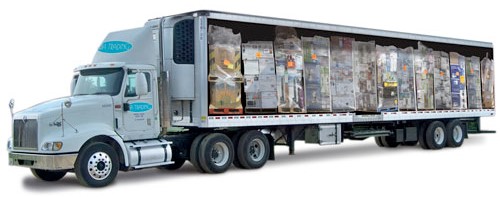REDWOOD LOGIN
Redwood PortalLTL
SCS
SCS Support
Rockfarm
In order to effectively choose between less than truckload and full truckload shipping, you must understand the variables associated with each. In this article, we define both shipping types and present what to consider when selecting the best method for your supply chain.
Less than truckload, or LTL, is a method of shipping that allows shippers to only pay for trailer space that they use per shipment. These are “less” than full truckload shipments. LTL shipments may consist of one to ten pallets that weigh anywhere from one hundred to ten thousand pounds.
LTL carriers leverage a ‘hub and spoke’ network of terminals where local terminals are the spokes and major distribution centers are the hubs. Using their terminal points, carriers can consolidate freight moving in similar directions offering cost effective pricing programs for shippers who may not always produce enough to fill an entire truck.

Full truckload, or FTL, is the transportation of 'like' cargo that fills up an entire trailer. Carriers can haul up to twenty-four standard pallets weighing up to forty-two thousand pounds. Shipments traveling via FTL pick up at an origin point ‘A’ and are hauled directly to the destination point ‘B.’
A key factor when determining which method is best to choose is understanding market differences.
The FTL market is saturated with over three hundred and fifty thousand owner-operators aiming to fill their trailers and haul freight across the United States. Using load boards, (software that allows carriers and shippers alike to post either freight needed to be moved or carrier availability based on area) carriers look to keep their trailer full as empty miles result in lost revenue, but a continued cost. This market is known as the full truckload spot market because rates are not-predetermined, but negotiated on the spot.
Within the spot market, a key factor is known as ‘backhauls.’ Backhauls are trips needed for a carrier to return to home after hauling a primary load. Empty miles generate zero revenue but still carry a cost (fuel, maintenance, tractor-trailer cost) making backhauls critical in the profitability of an FTL carrier.
Consider the following example:
Trucking company ABC Trucking is based out of Chicago, Illinois. In order to get revenue on their truck, they look for shipments originating in Chicago avoiding empty miles around pick-up. Let’s say they pick-up a load going from Chicago to Atlanta, Georgia. Once ABC Trucking delivers the primary shipment in Atlanta, they need to need to find a ‘backhaul’ shipment that will generate revenue for the return trip from Atlanta to Chicago in order to avoid empty miles.

In contrast, the LTL market has significantly fewer carriers to choose from. This is a result of a number of necessary assets required to manage LTL operations. Ten national LTL carriers service the domestic United States. A handful of LTL carriers specialize in a specific region of the country. For instance, Southeastern Freight Lines services the Southeast. New England Motor Freight covers the Northeast, Ontario, and Quebec.
LTL pricing programs are more complex than FTL pricing programs. Carriers offer various discount levels after analyzing the following factors:
LTL carriers also evaluate shipper’s freight when determining pricing. From product value to packaging specifications to analyzing shipping patterns, LTL carriers analyze each facet of a shipper’s freight before submitted pricing.

Both LTL and FTL offer different types of capacity. FTL is susceptible to peaks and valleys that can shift capacity either in the carrier’s favor or the shipper. Imagine a balance scale with the carriers on one side and the shippers on the other. Factors such as fuel, seasonal freight, driver availability, and tonnage all influence the scale as it relates to cost. For example, seasonal freight, such as produce, can drive shipper's freight cost two to three times higher than normal giving the carriers the advantage. On the other hand, shippers would realize lower cost if overall market tonnage was down.
LTL capacity is not as cyclical as FTL. Pricing contracts are typically held for a year at a time so shippers can negotiate and budget annually. This also benefits the carriers as they can account for capacity levels based on trends.
Both forms of shipping make sense for most shippers. If you produce enough product per shipment to fill an entire trailer, then FTL is the way to go. If you have shipments that take up minimal space, consider LTL to avoid paying for more than you use.
To learn more about this topic, please contact us using the link below.